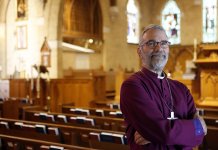The Archbishop of York, Stephen Cottrell, writes:
- “He became what we are so that we can be what he is”
St Athanasius (296-373 AD) - “For our sake he made him to be sin who knew no sin, so that in him we might become the righteousness of God.”
2 Corinthians 5. 21
Two images dominate western art. You can see them in every art gallery and in the stained glass windows of nearly every church.
One depicts a child in his mother’s arms. The other shows a young man dying on a cross.
The Christian faith says this child and this man are the same person. They say that he is God come down to earth.
This seems preposterous! It’s not how we think of God. Surely God is not a tiny child? Surely God doesn’t hang on a cross? Surely God – if he is God at all – is ‘all powerful’, ‘unchanging’, and ‘all knowing’.
In this man, and especially in the awful climax of his awful death, we are invited to consider God as one who is emptied of power, as one who shares the life of earth. This is always the first message of the Christianfaith. It is what we must declare before we declare anything else: God is with us.
But there is something else as well. The only reason these images endure and why new ones are made each year, is because the God who shared our life in Jesus and who died on the cross was also risen on the third day. God’s sharing in our humanity is for a purpose: so that our lives can be united with the life of God and even carried into glory.
Jesus, by his death and resurrection gives our lives and gives the whole world a new direction. The inner compass of our humanity is re-set. All this is the achievement of the man upon the cross. His purpose is to die and rise and take us with him. In his death, death is destroyed. In his life, life is restored: sins are forgiven and humanity is reconciled to God.
His name is Emmanuel, which means God is with us.
His name is Jesus, which means God saves.
+Stephen Ebor:










